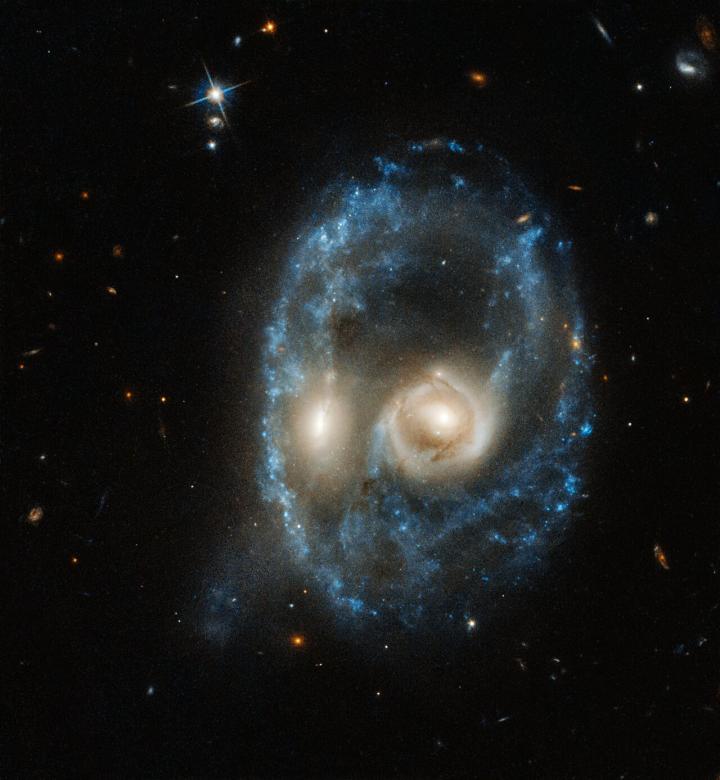
This new image from the NASA/ESA Hubble Space Telescope captures two galaxies of equal size in a collision that appears to resemble a ghostly face. This observation was made on…
view more
In celebration of Halloween, this new image from the NASA/ESA Hubble Space Telescope captures two galaxies of equal size in a collision that appears to resemble a ghostly face. This observation was made on 19 June 2019 in visible light by the telescope’s Advanced Camera for Surveys.
Although galaxy collisions are common — especially in the early universe — most are not head-on impacts like the collision that likely created this Arp-Madore system 704 million light-years from Earth. This violent encounter gives the system an arresting ring structure, but only for a short amount of time. The crash has pulled and stretched the galaxies’ discs of gas, dust, and stars outward, forming the ring of intense star formation that shapes the “nose” and “face” features of the system.
Ring galaxies are rare, and only a few hundred of them reside in our larger cosmic neighbourhood. The galaxies have to collide at just the right orientation so that they interact to create the ring, and before long they will have merged completely, hiding their messy past.
The side-by-side juxtaposition of the two central bulges of stars from the galaxies that we see here is also unusual. Since the bulges that form the “eyes” appear to be the same size, we can be sure that the two galaxies involved in the crash were of equal size. This is different from the more common collisions in which small galaxies are gobbled up by their larger neighbours.
This galaxy system is catalogued as Arp-Madore 2026-424 (AM 2026-424) in the Arp-Madore “Catalogue of Southern Peculiar Galaxies and Associations”. Astronomer Halton Arp published his compendium of 338 unusual-looking interacting galaxies in 1966. He later partnered with astronomer Barry Madore to extend the search for unique galactic encounters in the southern sky. Several thousand galaxies are listed in this 1987 survey.
Hubble observed this unique system as part of a “snapshot” programme that takes advantage of occasional gaps in the telescope’s observing schedule to squeeze in additional pictures. Astronomers plan to use this innovative Hubble programme to take a close look at many other unusual interacting galaxies. The goal is to compile a robust sample of nearby interacting galaxies, which could offer insights into how galaxies grew over time through galactic mergers. By analysing these detailed Hubble observations, astronomers will be able to decide which systems are prime targets for follow-up observations by the upcoming NASA/ESA/CSA James Webb Space Telescope, scheduled to launch in 2021.
###
More information
The Hubble Space Telescope is a project of international cooperation between ESA and NASA.
Links
- Images of Hubble – http://www.
spacetelescope. org/ images/ archive/ category/ spacecraft/ - HubbleSite Release – https:/
/ hubblesite. org/ contents/ news-releases/ 2019/ news-2019-51
Contacts
Julianne Dalcanton
University of Washington
Seattle, USA
Email: [email protected]
Ben Williams
University of Washington
Seattle, USA
Email: [email protected]
Bethany Downer
ESA/Hubble, Public Information Officer
Garching, Germany
Email: [email protected]
Media Contact
Bethany Downer
[email protected]
Original Source
http://www.




